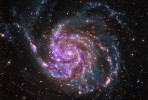Introduction and Science Goals


Our goal: to develop a nonlinear model that can be used in place of more complex models to describe the time evolution of synchronized astrophysical systems, such as moon formation, ring formation, spiral arm patterns or tidal locking of satellites.
The inspiration to approach astrophysical problems from this point of view came from Dr. Abrams' experience with coupled nonlinear oscillators. Nonlinear dynamics provide a way to utilize "big picture" characterizations about a system alternative to classical mechanics, statistical mechanics and electrodynamics.
While theories of synchronization in two- or three-body astronomical systems are well understood, a generalization to many-bodied systems remains largely unexplored. Historically, problems of resonant capture among astronomical bodies have been treated using methods from conservative classical mechanics. We investigate the possibility of using non-conservative models together with numerical methods to understand the phenomenon of resonant capture in large-scale structures such as rings, planetary systems and galactic spiral arms. In particular, we focus on N-body (N $\gg$ 1) dissipative systems such as circumplanetary discs and use methods drawn from the study of coupled oscillators.
One such method is inspired by the Kuramoto model, which describes mean field behavior in large ensembles of coupled nonlinear oscillators. The Kuramoto model can be modified to allow for non-mean field coupling, leading to the existence of chimera states, in which most of the oscillators synchronize. These chimera states can appear as clusters or spirals of synced oscillators, and may be suggestive of objects in astronomical contexts. We developed a mean-field model for N small particles in a dust ring around a massive planet, which can be tested through numerical experiments using code developed in MATLAB and Python. We are currently in the process of refining the code, after which the numerical experiments will begin.
